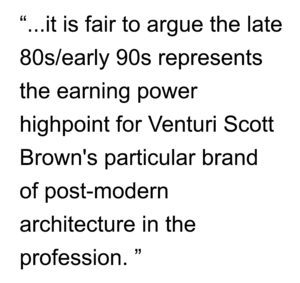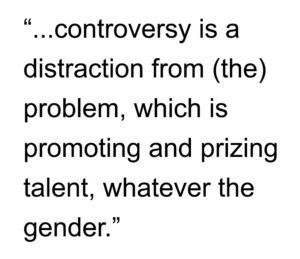Opinion: We need women designing buildings – CNN.com
We Need to Prize Talent, not Self-Promotion
by Dr. Mark David Major, AICP, CNU-A, The Outlaw Urbanist contributor
Denise Scott Brown should (have) be(en) recognized with Robert Venturi for the 1991 Pritzker Prize. However, the ongoing debate on this subject is frustrating. It is frustrating because the ideal of gender equality expounded for the architectural profession – and, by implication, other professions – too often relies on arguments that are, at best, manifestly superficial and, at worse, reinforce the gender stereotypes underlying the problem.
This particular debate has not been helped by public comments (perhaps taken of out context) by both Robert Venturi and Denise Scott-Brown that do not ‘hold water’ in explaining why she was not recognized with Venturi for the Pritzker Prize in the first place. For example, in the above CNN article, Scott Brown is quoted as saying””we could not afford to pass up the Pritzker Prize for the sake of our fledgling firm.” It seems far-fetched to describe Venturi Scott Brown and Associates as a “fledgling firm” in 1991. A Wikipedia listing of their selected works identifies four major projects in 1991, more than any other year listed over a 44-year period (Source: Wikipedia). Quite the opposite, in fact, since it is fair to argue the late 80s/early 90s represents the earning power highpoint for Venturi Scott Brown’s particular brand of post-modern architecture in the profession. Venturi and Scott Brown’s public comments suggest they are protecting somebody for the initial oversight, either Venturi himself or The Hyatt Foundation, which organizes and awards the Pritzker Prize.
However, this is a side issue to larger problems: namely, the promotion of talent, in general, and insidious effects of gender discrimination, in particular, in the architectural profession. Marika Shioiri-Clark and John Cary’s CNN opinion piece manages to negatively typify these problems at a gross level while still being right in some of its details. First, we do not need “women designing buildings.” This is the same superficial argument we have heard from feminists for decades; namely, if we only elected women to political leadership we would have world peace. Female political leaders have proven time and time again over the last 40 years that equality has nothing to do with their gender and everything to do with how women can be equally inspirational, vicious, divisive and (in)competent as their male counterparts. Instead, what we need are talented people (women and men) designing buildings. We should have zero interest in promoting mediocre architects, regardless of their gender.
 As Shioiri-Clark and Cary correctly point out, female architectural students regularly outperform their male counterparts in school, substantially so in our experience. If the profession truly prized and promoted talent, female architects would naturally rise to the top because there lies the talent (sorry, male architects but it is true). However, the profession is still trapped within the grips of the (often self-manufactured) ‘myth of architectural genius’. This practice prizes the architect’s ability to self-promote and network that myth in the profession, popular media, and books. In doing so, the superficial is valued over the substantive in architecture (very post-modern, indeed). Unfortunately, the profession’s manifest failure to promote talent also sweeps women architects out of the limelight as a result. Once you get pass the names Zaha Hadid, Denise Scott Brown and Elizabeth Plater-Zyberk, it’s damn difficult to name any superstar women architects. It’s even worse for planners (Jane Jacobs was an economist, so don’t even try it). However, “The fault, dear Brutus, is not in our stars, But in ourselves.” Our vision is my-opic (literally and metaphorically).
As Shioiri-Clark and Cary correctly point out, female architectural students regularly outperform their male counterparts in school, substantially so in our experience. If the profession truly prized and promoted talent, female architects would naturally rise to the top because there lies the talent (sorry, male architects but it is true). However, the profession is still trapped within the grips of the (often self-manufactured) ‘myth of architectural genius’. This practice prizes the architect’s ability to self-promote and network that myth in the profession, popular media, and books. In doing so, the superficial is valued over the substantive in architecture (very post-modern, indeed). Unfortunately, the profession’s manifest failure to promote talent also sweeps women architects out of the limelight as a result. Once you get pass the names Zaha Hadid, Denise Scott Brown and Elizabeth Plater-Zyberk, it’s damn difficult to name any superstar women architects. It’s even worse for planners (Jane Jacobs was an economist, so don’t even try it). However, “The fault, dear Brutus, is not in our stars, But in ourselves.” Our vision is my-opic (literally and metaphorically).
Shioiri-Clark and Cary also correctly call out the Architectural Registration Exam (ARE) process for institutionalizing discriminatory practices against women but then incorrectly name the reason (i.e. financial). The real discriminatory practice against women associated with the ARE lies in the limit to a 6-month reporting period for the Intern Development Program (IDP). When a woman temporarily leaves the workforce to bear a child, the typical disruption to her career is much longer than 6 months. Sure, there are some ‘super’ women out there in the profession, for whom this is not the case. They may work until 4-6 weeks before giving birth and return to work 3-4 weeks afterwards. But, more typically, the disruption to a woman’s career extends over a two-year period from the early decision-making stages of pregnancy to the early childhood-raising stages after birth. Let’s be honest, given the supreme and unchallenged role that mothers play in raising their children (especially compared to fathers), the real disruption is 18 years… or even a lifetime. In any case, the one thing the profession could do today to promote gender equality and enable more women to become registered architects is extend the reporting period for IDP to two years.
In their opinion piece, Shioiri-Clark and Cary then transition to the visibility of women architects in the profession. If we focus the question on the promotion of talent instead of valuing the promotion of self, then this is the same problem, i.e. the crème will rise to the top if we value talent.

At this point, the Shioiri-Clark and Cary article takes a mind-bogglingly bizarre turn to discuss “Architect Barbie”, which manages to be both comical and hypocritical, thereby undercutting every point they are trying to make in the article. Perhaps it’s true that Shioiri-Clark and Cary only do this to spark controversy and drive visitor hits on the article. However, when it comes to the larger question of gender discrimination, it’s hard to get more inconsequential than discussing dolls within the context of a serious subject.
Shioiri-Clark and Cary close the article by further expounding further on the ‘world would be a better place if it was run by women’ argument/fallacy. It would not be any different except women would more equally share in the blame for our problems as well as the praise when those problems are solved.  That is true equality. So give Denise Scott Brown her share of the 1991 Pritzker Prize but women and men should not make the mistake of thinking it addresses the real problem in the profession. At this point, the Pritzker Prize controversy is a distraction from that problem, which is promoting and prizing talent, whatever the gender. If the playing field was level in this regard, there is little doubt women would rise en masse to the top of the profession… and our built environment would, indeed, be better served.
That is true equality. So give Denise Scott Brown her share of the 1991 Pritzker Prize but women and men should not make the mistake of thinking it addresses the real problem in the profession. At this point, the Pritzker Prize controversy is a distraction from that problem, which is promoting and prizing talent, whatever the gender. If the playing field was level in this regard, there is little doubt women would rise en masse to the top of the profession… and our built environment would, indeed, be better served.
Read the full CNN.com article here: Opinion | We need women designing buildings – CNN.com





 The circus of Senate confirmation hearings for the Secretary of Cities, brought to you by National Ready Mixed Concrete Association and Community Organizations International, just as soon as the Senator from Montana releases his hold on the nomination! Stay tuned! More pigs feeding at the Federal trough would inevitably populate Florida’s Department of Cities. That is fine for the pigs but what about the rest of us?
The circus of Senate confirmation hearings for the Secretary of Cities, brought to you by National Ready Mixed Concrete Association and Community Organizations International, just as soon as the Senator from Montana releases his hold on the nomination! Stay tuned! More pigs feeding at the Federal trough would inevitably populate Florida’s Department of Cities. That is fine for the pigs but what about the rest of us? The only way a Federal Department of Cities could alter the prevailing development paradigm in this country for the last century is if we are willing to place Smart Growth for our cities at the top of the agenda by subsuming the Department of Transportation, Department of Housing and Urban Development, Environmental Protection Agency, and other disparate Federal agencies and offices (Office of Urban Affairs, and so on) under one roof. Incidentally, this is probably the only way a new Department of Cities could generate bipartisan support by allowing the left and the right to explicitly address their key constituencies (urban interests on one hand, reducing and streamlining government on the other). It would also require both parties adopting an united front to take on other special interests threatened by such reform (most obviously, radical environmentalists). In the absence of such radical thinking, our cities are safer as “laboratories for pragmatic bipartisan policy innovation, pioneering new approaches on everything from schools, crime and gun control to economic development” at the local and State level.
The only way a Federal Department of Cities could alter the prevailing development paradigm in this country for the last century is if we are willing to place Smart Growth for our cities at the top of the agenda by subsuming the Department of Transportation, Department of Housing and Urban Development, Environmental Protection Agency, and other disparate Federal agencies and offices (Office of Urban Affairs, and so on) under one roof. Incidentally, this is probably the only way a new Department of Cities could generate bipartisan support by allowing the left and the right to explicitly address their key constituencies (urban interests on one hand, reducing and streamlining government on the other). It would also require both parties adopting an united front to take on other special interests threatened by such reform (most obviously, radical environmentalists). In the absence of such radical thinking, our cities are safer as “laboratories for pragmatic bipartisan policy innovation, pioneering new approaches on everything from schools, crime and gun control to economic development” at the local and State level. Why would we expect our citizens (and their representatives) to ever trust us and put us in charge when we have demonstratively failed our cities time and time again during their lifetime, their parents’ lifetime, and their grandparents’ lifetime? Instead of searching for magic bullets (like Florida’s idea), let us dedicate ourselves to leading for our cities. The irony is, if we truly did this, we would probably find the perceived need for Florida’s proposal and others like them would disappear. Unless, of course, the point is to become one of the fattest pigs at the trough. If this is the case, then never mind…
Why would we expect our citizens (and their representatives) to ever trust us and put us in charge when we have demonstratively failed our cities time and time again during their lifetime, their parents’ lifetime, and their grandparents’ lifetime? Instead of searching for magic bullets (like Florida’s idea), let us dedicate ourselves to leading for our cities. The irony is, if we truly did this, we would probably find the perceived need for Florida’s proposal and others like them would disappear. Unless, of course, the point is to become one of the fattest pigs at the trough. If this is the case, then never mind…

 However, it does seem to contradict the findings of a recent survey by the International Association of Ice Cream Distributors & Vendors that suggested 96% of American children actually want ice cream for every meal. A spokesman for the American Dental Association was kind enough to take time away from a vacation on his yacht off the coast of Barbados to comment, “We don’t see how the results of these different surveys about what American children want to be provided for their daily nutrient requirements can be viewed as in conflict with one another in any feasible manner.”
However, it does seem to contradict the findings of a recent survey by the International Association of Ice Cream Distributors & Vendors that suggested 96% of American children actually want ice cream for every meal. A spokesman for the American Dental Association was kind enough to take time away from a vacation on his yacht off the coast of Barbados to comment, “We don’t see how the results of these different surveys about what American children want to be provided for their daily nutrient requirements can be viewed as in conflict with one another in any feasible manner.”